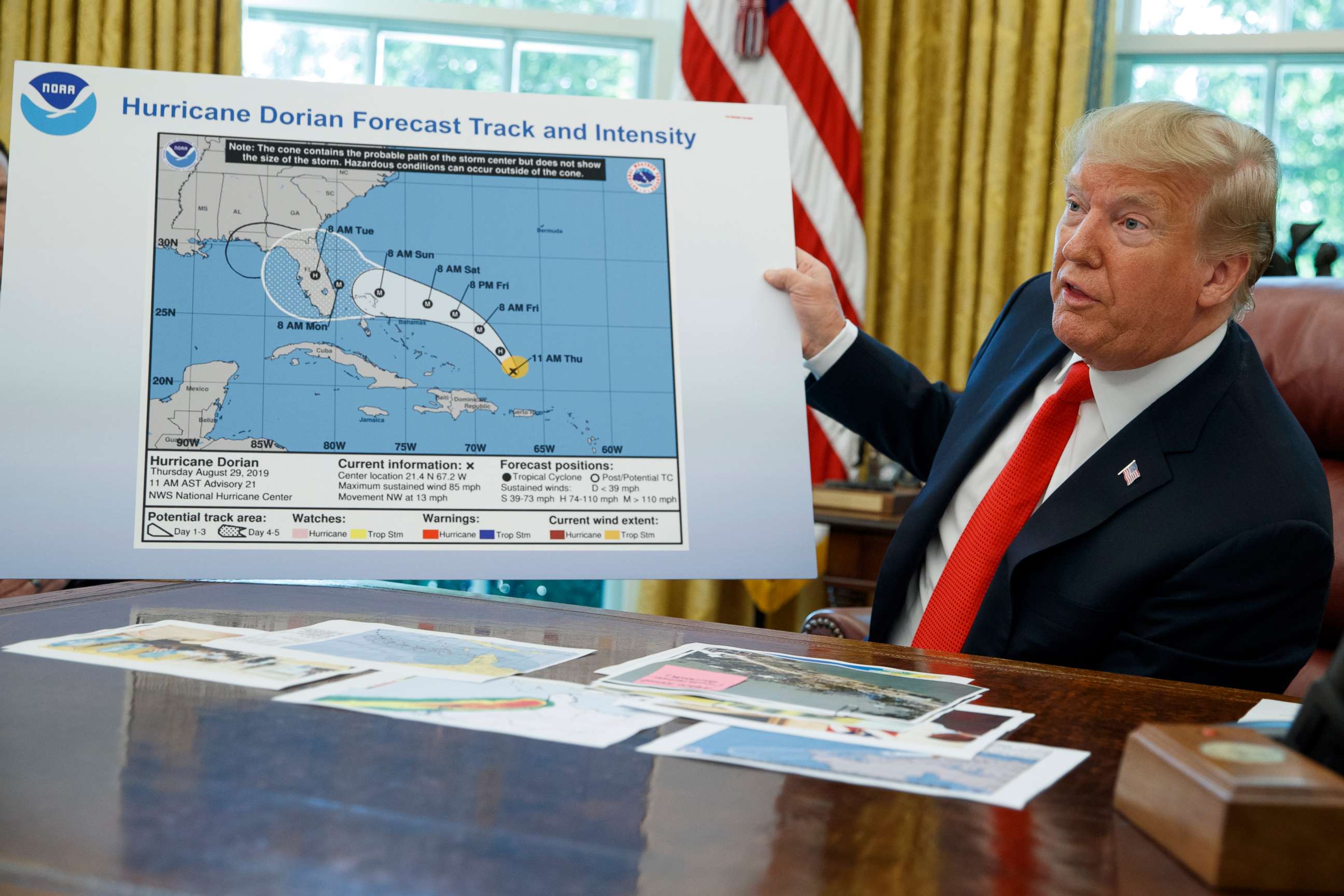Trump not backing down on claim that Alabama could have been hit by Hurricane Dorian
Trump tweeted Thursday repeating idea that Alabama faced danger from Dorian.
President Donald Trump is not backing down on his claim that Alabama could have been hit by Hurricane Dorian -- even after government meteorologists disputed that was the case.
"In the early days of the hurricane, when it was predicted that Dorian would go through Miami or West Palm Beach, even before it reached the Bahamas, certain models strongly suggested that Alabama & Georgia would be hit as it made its way through Florida & to the Gulf," Trump tweeted Thursday morning.
Thursday afternoon, he tweeted National Hurricane Center maps from last Thursday and last Friday showing potential winds from Dorian stretching into Alabama, and shared a tweet from the Alabama National Guard last Friday warning of the storm potentially heading in Alabama's direction.
But those maps -- and the Alabama National Guard's tweet -- were from days before Trump mentioned Alabama on Sunday. Wind-probability maps from such an early stage include a broad swatch of land because of the inherent error in forecasting a storm so many days in advance.
By Sunday, all weather models had come into agreement that there was virtually no chance Alabama would be impacted by the storm. The forecast track had changed, with Dorian expected to turn northward and move up the East Coast.
Later Thursday, the White House released a statement from an official who briefed the president on the hurricane over the weekend. Peter Brown, Trump’s homeland security and counterterrorism adviser, wrote that the president’s comments on Sunday about Alabama "were based on that morning’s Hurricane Dorian briefing, which included the possibility of tropical storm force winds in southeastern Alabama" -- a possibility he said lasted until Monday morning.
A National Hurricane Center map from Monday morning shows a tiny part of southeastern Alabama having a small, 5 to 10% chance of seeing tropical storm-force winds, or winds of 39 mph or greater. Every state up the East Coast had at least the same slight chance -- including New York, Maine and other northeastern states, although Trump never mentioned the slight threat to those.
The president first drew criticism for this claim Sunday after saying multiple times that Alabama was in the storms path, tweeting, "In addition to Florida - South Carolina, North Carolina, Georgia, and Alabama, will most likely be hit (much) harder than anticipated." Soon after, the National Weather Service tweeted that was not the case. At about the same time, Trump repeated that claim to reporters at the White House, saying, "Alabama is going to get a piece of it, it looks like."
During an Oval Office briefing on Dorian Wednesday, Trump clung to the idea by displaying a National Hurricane Center map that appeared to have a drawn-on semicircle appended to the "cone of uncertainty" showing the hurricane's potential projected impact -- extending the cone into Alabama.

"This is the original path that we thought -- and everybody thought that this was about a 95% probability," he said. "And it turned out to be not that path. It turned out to be a path going up the coast," Trump said.
Hours after the Wednesday Dorian briefing, at a different event in the afternoon, Trump later denied knowing how or why the map had been altered when asked if he could explain how the change was made.
"No, I just know, yeah. I know that Alabama was in the original forecast," he said. "They thought it would get it, as a piece of it, it was supposed to go -- actually we have a better map of that which is going to be presented, where we had many lines going directly -- many models, each line being a model. And they were going directly through. And in all cases, Alabama was hit. If not likely, in some cases pretty hard. Georgia and Alabama, it was a different route. They actually gave that a 95% chance probability," he said.
"That map that you showed us today, looked like it almost had, like, a Sharpie written on it," a reporter said during a second White House event on Wednesday.
Trump cut off the reporter and said, "I don't know. I don't know. I don't know." He also said the map had been from three or four days before, when it had actually been issued six days earlier.
White House deputy press secretary Hogan Gidley tweeted Wednesday night that the line was, in fact, from a black Sharpie, and he criticized the media for focusing on it.
At one point last Friday, one forecast map did show a cone that brushed the Alabama-Florida border, but it did not go nearly as far.
ABC News' Elizabeth Thomas, Mel Griffin and Dan Peck contributed reporting to this article.




